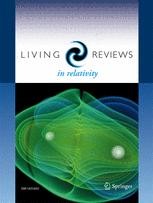Living Reviews in Relativity: "Observing and localizing gravitational-wave transients with Advanced LIGO, Advanced Virgo and KAGRA" (Update)
 Abbott, B.P. et al. (KAGRA Collaboration, LIGO Scientific Collaboration and Virgo Collaboration), "Prospects for observing and localizing gravitational-wave transients with Advanced LIGO, Advanced Virgo and KAGRA", Living Rev Relativ (2018) 21: 3. https://doi.org/10.1007/s41114-018-0012-9
Abbott, B.P. et al. (KAGRA Collaboration, LIGO Scientific Collaboration and Virgo Collaboration), "Prospects for observing and localizing gravitational-wave transients with Advanced LIGO, Advanced Virgo and KAGRA", Living Rev Relativ (2018) 21: 3. https://doi.org/10.1007/s41114-018-0012-9
Open Access | Review Article
First Online: 26 April 2018
Major revision, updated and expanded.
Abstract:
We present possible observing scenarios for the Advanced LIGO, Advanced Virgo and KAGRA gravitational-wave detectors over the next decade, with the intention of providing information to the astronomy community to facilitate planning for multi-messenger astronomy with gravitational waves. We estimate the sensitivity of the network to transient gravitational-wave signals, and study the capability of the network to determine the sky location of the source. We report our findings for gravitational-wave transients, with particular focus on gravitational-wave signals from the inspiral of binary neutron star systems, which are the most promising targets for multi-messenger astronomy. The ability to localize the sources of the detected signals depends on the geographical distribution of the detectors and their relative sensitivity, and 90% credible regions can be as large as thousands of square degrees when only two sensitive detectors are operational. Determining the sky position of a significant fraction of detected signals to areas of 5–20 deg2 requires at least three detectors of sensitivity within a factor of ∼2 of each other and with a broad frequency bandwidth. When all detectors, including KAGRA and the third LIGO detector in India, reach design sensitivity, a significant fraction of gravitational-wave signals will be localized to a few square degrees by gravitational-wave observations alone.
Changes:
Major revision, updated and expanded. Several updates to the document have been made. The most significant changes are the inclusion of details regarding KAGRA, and results from O1 and O2, including GW170817, the first detection with an unambiguous multi-messenger counterpart. The key differences are outlined in an appendix.
